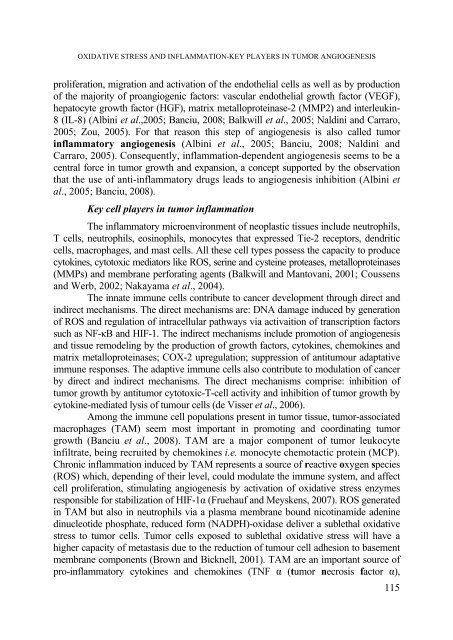biologia - Studia
biologia - Studia
biologia - Studia
You also want an ePaper? Increase the reach of your titles
YUMPU automatically turns print PDFs into web optimized ePapers that Google loves.
OXIDATIVE STRESS AND INFLAMMATION-KEY PLAYERS IN TUMOR ANGIOGENESIS<br />
proliferation, migration and activation of the endothelial cells as well as by production<br />
of the majority of proangiogenic factors: vascular endothelial growth factor (VEGF),<br />
hepatocyte growth factor (HGF), matrix metalloproteinase-2 (MMP2) and interleukin-<br />
8 (IL-8) (Albini et al.,2005; Banciu, 2008; Balkwill et al., 2005; Naldini and Carraro,<br />
2005; Zou, 2005). For that reason this step of angiogenesis is also called tumor<br />
inflammatory angiogenesis (Albini et al., 2005; Banciu, 2008; Naldini and<br />
Carraro, 2005). Consequently, inflammation-dependent angiogenesis seems to be a<br />
central force in tumor growth and expansion, a concept supported by the observation<br />
that the use of anti-inflammatory drugs leads to angiogenesis inhibition (Albini et<br />
al., 2005; Banciu, 2008).<br />
Key cell players in tumor inflammation<br />
The inflammatory microenvironment of neoplastic tissues include neutrophils,<br />
T cells, neutrophils, eosinophils, monocytes that expressed Tie-2 receptors, dendritic<br />
cells, macrophages, and mast cells. All these cell types possess the capacity to produce<br />
cytokines, cytotoxic mediators like ROS, serine and cysteine proteases, metalloproteinases<br />
(MMPs) and membrane perforating agents (Balkwill and Mantovani, 2001; Coussens<br />
and Werb, 2002; Nakayama et al., 2004).<br />
The innate immune cells contribute to cancer development through direct and<br />
indirect mechanisms. The direct mechanisms are: DNA damage induced by generation<br />
of ROS and regulation of intracellular pathways via activaition of transcription factors<br />
such as NF-κB and HIF-1. The indirect mechanisms include promotion of angiogenesis<br />
and tissue remodeling by the production of growth factors, cytokines, chemokines and<br />
matrix metalloproteinases; COX-2 upregulation; suppression of antitumour adaptative<br />
immune responses. The adaptive immune cells also contribute to modulation of cancer<br />
by direct and indirect mechanisms. The direct mechanisms comprise: inhibition of<br />
tumor growth by antitumor cytotoxic-T-cell activity and inhibition of tumor growth by<br />
cytokine-mediated lysis of tumour cells (de Visser et al., 2006).<br />
Among the immune cell populations present in tumor tissue, tumor-associated<br />
macrophages (TAM) seem most important in promoting and coordinating tumor<br />
growth (Banciu et al., 2008). TAM are a major component of tumor leukocyte<br />
infiltrate, being recruited by chemokines i.e. monocyte chemotactic protein (MCP).<br />
Chronic inflammation induced by TAM represents a source of reactive oxygen species<br />
(ROS) which, depending of their level, could modulate the immune system, and affect<br />
cell proliferation, stimulating angiogenesis by activation of oxidative stress enzymes<br />
responsible for stabilization of HIF-1α (Fruehauf and Meyskens, 2007). ROS generated<br />
in TAM but also in neutrophils via a plasma membrane bound nicotinamide adenine<br />
dinucleotide phosphate, reduced form (NADPH)-oxidase deliver a sublethal oxidative<br />
stress to tumor cells. Tumor cells exposed to sublethal oxidative stress will have a<br />
higher capacity of metastasis due to the reduction of tumour cell adhesion to basement<br />
membrane components (Brown and Bicknell, 2001). TAM are an important source of<br />
pro-inflammatory cytokines and chemokines (TNF α (tumor necrosis factor α),<br />
115
















